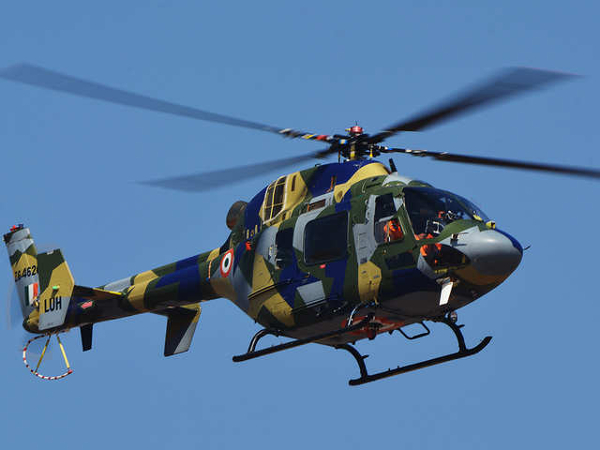HAL’s Light Utility Helicopter has received initial operational clearance for military use, but the aircraft may also find a home in the civilian sector. While the single-engine LUH is getting set for its military debut, highly-placed sources at HAL indicate the company plans to position the LUH for civil applications, too.
The LUH is HAL’s latest rotary product after the light twin Advanced Light Helicopter (ALH) and Light Combat Helicopter (LCH). The three-ton helicopter incorporates a glass cockpit, dual controls and a single Safran Ardiden 1U1 turboshaft engine. As of January 2020, three LUH prototypes have logged over 550 flights under various environmental conditions.
The Indian forces’ requirement to operate from sea level to helipads at over 20,000 feet imposes unique challenges on rotorcraft. Successive models of light helicopters from HAL’s stable have targeted such requirements through collaboration and in-house development.
The LUH forms part of the Indian army and air force’s long-standing need for 394 light helicopters to replace ageing Cheetahs (Lama) and Chetaks (Alouette III). Of these, 187 would be the LUH (126 for the army & 61 for the air force). The remainder of the aircraft are expected to arrive through an Inter-Governmental Agreement (IGA) for 197 Ka-226T helicopters, to be manufactured by Indo-Russian Helicopters Limited (IRHL) – a HAL-Russian Helicopters joint venture company.
But the military market may just be the beginning of the LUH’s penetration in India. A video shared on Twitter quotes Unni Pillai, HAL’s chief test pilot, as saying “it (LUH) is a military aircraft right now, but it’ll be in the civil variant soon.”
The statement, made during the Defexpo, has been corroborated by senior HAL officials. Coming soon after IOC, it indicates HAL’s willingness to engage with civil customers, possibly eyeing a market outside the armed forces.
A senior member of the LUH design team, who asked for their name to be withheld, said HAL is expecting to deliver over 600 LUHs within the civil sector. The customers would be Indian “to start with,” and the target sectors are tourism, air ambulance, and utility, while the six to seven-seater aircraft can also be configured as a four-seater VIP helicopter.
“Civil certification is being progressed concurrently,” the source said, adding that the Indian regulator, DGCA, has been looped in throughout the military certification process.
“HAL aims to meet all civil certification requirements within next 4-5 years,” they added. “EASA [European Aviation Safety Agency] certification is expected to take another eight months from receipt of civil certification from DGCA.”
Large parts of hilly terrain in north and northeast India are currently serviced by single engine helicopters like the Bell 407 and Airbus Helicopters AS350 B3. If the indigenous LUH achieves civil certification and proves itself, it may offer a competing product to Indian operators in the heli-tourism and commuter roles.
HAL’s civil-certified ALH flies in limited numbers in India. Non-military customers of the ALH are limited to the Border Security Force (BSF), Pawan Hans Limited (PHL) and a few other government agencies, totalling just four to five helicopters.
There are about 350 civil helicopters flying in India today, and HAL’s plans to tap the civil market with LUH, however tentative, could mark a new chapter in Indian aerospace. The LUH will face stiff competition from proven products that Indian customers have been operating for years, with a need to prove a competitive operating cost and availability rate with these established types. HAL officials quoted their recent self-deployment of 7,000 kilometers over 17 days for ‘hot and high’ trials to reiterate that the LUH’s “reliability is proven.” After 200 to 250 hours of flight and servicing that followed, they found the three main components – gearbox, engine and rotors to be in “very good” condition.
A senior member of the LUH design team said they are targeting “over 90 percent aircraft serviceability,” having done away with the problematic Integrated Dynamic System that plagued the ALH since inception. The “two-segmented blade” adopted for the first time on the LUH rotor system offers a compact folded dimension, easy transportability and interchangeability, he said. This technology is planned to be ported on the ALH in due course, as per HAL.
Source: Vertical Mag
Image Courtesy: The Economic Times
You may also like
-
IAF Aircraft Set Course For Exercise Eastern Bridge VII At Oman
-
IAF Set To Host The Indian Defence Aviation Exposition-II At Jodhpur
-
Defence Secretary to co-chair 5th India-Philippines Joint Defence Cooperation Committee meeting in Manila
-
Simultaneous Launch Of ‘malpe And Mulki’, Fourth And Fifth Ships Of Asw Swc (Csl) Project
-
Aatmanirbharta in Defence: MoD signs Contract with HAL for 240 AL-31FP Aero Engines for Su-30MKI Aircraft
